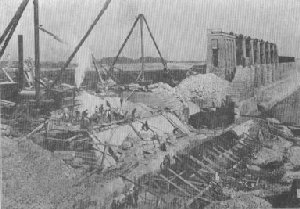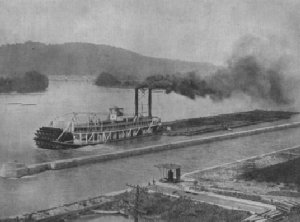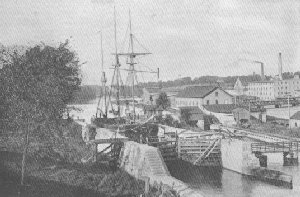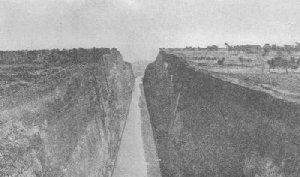|
MONSTER SHIP CANALS
The necessity of a canal to connect the Atlantic and Pacific oceans has long been apparent and great amounts have been expended in efforts to accomplish it.
THE PANAMA CANAL PROJECT.
 | | How canals are made. |
From the standpoint of many expert scientific engineers the Panama route, which followed the course of the waterway connecting Colon on the Atlantic with Panama on the Pacific, was considered more feasible than that across Nicaragua, which was to run from Greytown on the Atlantic side to Brito on the Pacific, and included the use of the San Juan river and Lake Nicaragua. On January 4, 1904, the French bondholders of the Panama route offered their plant to the United States for $40,000,000. It had already been cut about two-thirds of the way across the isthmus. The United States offered Colombia $10,000,000 upon the ratification of the Hay-Herran treaty, which gave the former the right to build the canal. This was rejected by the Colombians and, on November 6, 1903, the American government recognized the independence of Panama and entered into a treaty with the new republic which granted to the United States the control of the canal zone and authorized the Panama Company to sell its rights for the sum offered. On April 27, 1904, the title to the property was formally transferred to the United States.
THE SUEZ CANAL.
 | | An upwater canal—"stern-wheeler" pushing raft of logs. |
The Suez canal, connecting the Mediterranean and Red seas, is 100 miles long and was constructed in ten years at a cost of $100,000,000. The idea of such an artificial waterway first came to Napoleon Bonaparte, but was given up when it was supposed that the Red Sea was thirty feet above the Mediterranean. In 1841, when British scientists proved this to be an error, Ferdinand de Lesseps began to investigate the problem of a canal. In 1856, by permission of the Khedive of Egypt and the Sublime Porte, the Universal Company of the Maritime Suez Canal was formed. Half the capital for conducting the work was raised by popular subscription, mostly in France. The other half was raised by the Khedive. Work was begun April 25, 1859, and on November 16, 1869, the canal was opened for navigation. The route of this canal includes Lake Menzaleh, Lake Timsah and the Bitter Lakes. Originally, the canal was from 150 to 300 feet wide at the surface of the water, and 72 feet wide at the bottom, with a minimum depth of 26 feet. In later years it has been considerably widened and deepened to 28 feet.
The British government now owns the shares originally owned by the Khedive. From 486 vessels and $1,031,865 earned the first year of the canal's history, its business has increased nearly twenty fold.
THE CHICAGO DRAINAGE CANAL.
 | | Drainage canal view at Lockport, Illinois. |
A work of recent construction and great importance is the Drainage Canal of Chicago. The purpose of this canal is to turn backwards the water of the Chicago river that for years polluted Lake Michigan and Chicago's drinking-water supply with the filth of the city's sewers. For years the Chicago river served as a sewer for the city, draining every factory, slaughter house and cesspool of the district. Sanitary engineers believed that a wide canal connecting the Chicago river with the Desplaines river and thus flushing off the water through the Illinois river into the Mississippi would remove this great danger to health. From this canal some day will develop a great waterway from the Great Lakes to the Gulf of Mexico, for, all that is needed is the further dredging of several streams along the route. The water from Lake Michigan flows up stream in the Chicago river and out through a cut that connects with the south branch of the river, to Lockport, Illinois, where, through a great dam and controlling works, it runs into the Desplaines river, to Joliet, and through the Illinois river into the Mississippi. The cut is 160 feet wide, is constructed of masonry six feet thick, has a capacity of 600,000 cubic feet of water a minute, and will admit ocean vessels. The whole sewer system of Chicago is being reversed to flow into the canal.
A great agitation was raised in towns along the Mississippi river when the sewage of Chicago was turned into the canal, because of fear that it might contaminate the Mississippi, which furnishes the water supply for those cities. Bacteriologists, however, proved that there was no danger from this source.
THE KILE CANAL.
 | | Corinth Canal—Greece. |
One of the greatest ship canals of the old world, when completed, will be the Kile, connecting the Baltic with the Black Sea. Work was begun on this in 1898 by the Russian government. The route lies along the River Dnieper which flows into the Black Sea and connects this river with the Dwina river which empties into the Baltic sea at Riga. It begins at Riga, runs along the Dwina as far as Duneberg where it is connected with the Beresina by a great cut across country. Thence the Beresina and Dnieper complete the connection with the Black Sea. The total length of the line is about 1,000 miles and about 125 miles of the distance is through an artificial cut. The canal is 307 feet wide and about 30 feet deep, thus allowing vessels of greatest draught to pass from one sea to the other. The cost of the enterprise will be about $120,000,000, allowing for the use of convict labor by the Russian government. The whole canal will be under Russian sovereignty, thus being of great political significance. Seventeen large ports will be established along the line to enable vessels to make harbor when so desired. The route can be traversed in six days.
GREAT STRIDES IN THE OIL INDUSTRY
HIGH-GRADE TOBACCO GROWN UNDER MAMMOTH TENTS
Table of Contents
Return to Main Page
© 1998, 2002 by Lynn Waterman
|



